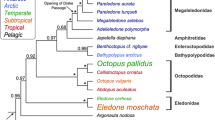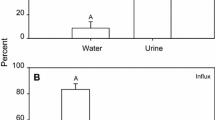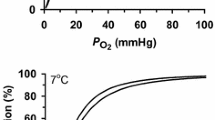Summary
-
1.
A study has been made of the oxygen and carbon dioxide transporting properties of the blood of three species of crab,Goneplax rhomboides, a species which constructs semi-permanent burrows in sublittoral muds, andAtelecyclus rotundatus andLiocarcinus depurator which simply bury themselves in the substratum. Investigations were also made of thein vivo blood/gas parameters in these three species. The oxygen carrying capacity of the blood was similar in all three species (0.31–0.34 μmol·ml−1) as were arterial and venous oxygen tensions. Arterial and venous blood pH values were not significantly different but inL. depurator pHa was 8.08 compared with 7.81 in the other two species. At pH 7.8 and 10°C the oxygen affinity of the blood ofA. rotundatus (P 50=5.6 Torr) andG. rhomboides (P 50=4.1 Torr) was higher than that ofL. depurator (P 50=24.3 Torr). Oxygen affinity was relatively temperature independent between 5–15°C inA. rotundatus and inL. depurator butG. rhomboides exhibited a normal temperature dependence (ΔH=−64 kJ·mole−1). The Bohr effect was much larger inL. depurator (ϕ=−1.43) than inA. rotundatus (ϕ=−0.92) andG. rhomboides (ϕ=−0.59).
-
2.
The haemocyanin of all three species exhibited a pronounced lactate effect i.e. an increase in blood lactate concentration increased the oxygen affinity of the haemocyanin, and inA. rotundatus it was also possible to demonstrate the existence of an unidentified factor in the blood which slightly increased the oxygen affinity of the haemocyanin. InA. rotundatus and inL. depurator, but not inG. rhomboides, an increase in blood lactate concentration caused a decrease in the cooperativity of the haemocyanin.
-
3.
The blood ofA. rotundatus, G. rhomboides andL. depurator had a high capacitance for CO2 transport at physiological CO2 tensions and also exhibited a distinct Haldane effect, the magnitude of which differed between these species. The buffer value of the blood of these crabs was low (Δ[HCO3]/ΔpH=−4.93 to −5.99 mmol·l−1·pH unit−1). The observed differences in the oxygen and carbon dioxide transporting properties of the blood of these three species of crab are discussed in relation to their mode of life.
Similar content being viewed by others
References
Altman PL, Dittmer DS (1971) Respiration and Circulation. Federation of American Society of Experimental Biologists, Bethesda (Biological Handbook, Vol 3)
Atkinson RJA (1974) Behavioral ecology of the mud-burrowing crabGoneplax rhomboides. Mar Biol 25:239–252
Booth CE, McMahon BR, Pinder AW (1982) Oxygen uptake and the potentiating effects of increased hemolymph lactate on oxygen transport during exercise in the blue crab,Callinectes sapidus. J Comp Physiol 148:111–121
Bridges CR (1977) A study of the respiratory physiology ofGalathea strigosa (L.) andCorystes cassivelaunus (Pennant). PhD thesis, University of Liverpool
Bridges CR (1979) Adaptations ofCorystes cassivelaunus to an arenicolous mode of life. In: Naylor E, Hartnoll RG (eds) Cyclic phenomena in marine plants and animals. Pergamon Press (Proceedings of the 13th European Marine Biology Symposium, pp 317–324)
Bridges CR, Bicudo JEPW, Lykkeboe G (1979) Oxygen content measurements in blood containing haemocyanin. Comp Biochem Physiol 62A:457–462
Bridges CR, Brand AR (1980) The effect of hypoxia on oxygen consumption and blood lactate levels of some marine Crustacea. Comp Biochem Physiol 65A:399–409
Bridges CR, Morris S, Grieshaber MK (1984) Modulation of haemocyanin oxygen affinity in the intertidal prawnPalaemon elegans (Rathke). Resp Physiol 57:189–200
Cameron JN (1971) Rapid method for determination of total carbon dioxide in small blood samples. J Appl Physiol 31:632–634
Chapman CJ, Rice AL (1971) Some direct observations on the ecology and behaviour of the Norway lobsterNephrops norvegicus. Mar Biol 10:321–329
Cumberlidge N, Uglow RF (1977) Heart and scaphognathite activity during the digging behaviour of the shore crab,Carcinus maenas (L.). In: McLusky DS, Berry AJ (eds) Physiology and behaviour of marine organisms. Pergamon Press (Proceedings of the 12th European Marine Biology Symposium, pp 23–30)
Graham RA, Mangum CP, Terwilliger RC, Terwilliger NB (1983) The effect of organic acids on oxygen binding of haemocyanin from the crabCancer magister. Comp Biochem Physiol 74A:45–50
Gutman I, Wahlefeld AW (1974) L-(+)-Lactate determination with lactate dehydrogenase and NAD. In: Bergmeyer HU (ed) Methods in enzymic analysis. Academic Press, London New York (2nd English ed, pp 1464–1468)
Jokumsen A, Weber RE (1982) Haemocyanin oxygen affinity in hermit crab blood is temperature independent. J Exp Zool 221:389–394
Johnson BA, Bonaventura C, Bonaventura J (1984) Allosteric modulation ofCallinectes sapidus hemocyanin by binding ofl-lactate. Biochemistry 23:872–878
Lykkeboe G, Johansen K, Maloiy GMD (1975) Functional properties of haemoglobins in the teleostTilapia grahami. J Comp Physiol 104:1–11
Mangum CP (1983a) Oxygen transport in the blood. In: Bliss DE (ed) The biology of Crustacea, vol 5. Academic Press, New York London, pp 373–429
Mangum CP (1983b) On the distribution of lactate sensitivity among hemocyanins. Mar Biol Lett 4:139–149
Miller WI, Pritchard AW, Rutledge PS (1976) Respiratory regulation and the role of the blood in the burrowing shrimpCallianassa californiensis (Decapoda: Thalassinidae). Mar Biol 36:233–242
Morris S, Taylor AC, Bridges CR, Grieshaber MK (1985) Respiratory properties of the haemolymph of the intertidal prawn,Palaemon elegans (Rathke). J Exp Zool 233:175–186
Nash RDM, Chapman CJ, Atkinson RJA, Morgan PJ (1984) Observations on the burrows and burrowing behaviour ofCalocaris macandreae (Crustacea: Decapoda: Thalassinoidea). J Zool (Lond) 202:425–439
Ott JA, Fuchs B, Fuchs R, Malasek A (1976) Observations on the biology ofCallianassa stebbingi Borradaille andUpogebia littoralis Risso and their effect upon the sediment. Senckenbergiana Marit 8:61–79
Powers LW, Bliss DE (1983) Terrestrial adaptations. In: Bliss DE (ed) The biology of Crustacea, vol 8. Academic Press, New York London, pp 271–333
Rice AL, Chapman CJ (1971) Observations on the burrows and burrowing behaviour of two mud-dwelling decapod crustaceans,Nephrops norvegicus andGoneplax rhomboides. Mar Biol 10:330–342
Sick H, Gersonde K (1969) Method for continuous registration of O2 binding curves of haemoproteins by means of a diffusion chamber. Anal Biochem 32:362–376
Taylor AC (1984) Branchial ventilation in the burrowing crab,Atelecyclus rotundatus. J Mar Biol Assoc UK 64:7–20
Thompson RW, Pritchard AW (1969) Respiratory adaptations of two burrowing crustaceansCallianassa californiensis andUpogebia puttensis. Biol Bull 136:274–287
Truchot J-P (1976) Carbon dioxide combining properties of the blood of the shore crab,Carcinus maenas (L.): CO2 dissociation curves and the Haldane effect. J Comp Physiol 112:283–293
Truchot J-P (1980) Lactate increases the oxygen affinity of crab haemocyanin. J Exp Zool 214:205–208
Tucker VA (1967) Method for oxygen content and dissociation curves on microliter blood samples. J Appl Physiol 23:410–414
Warner GE (1977) The biology of crabs. Elek Science, London
Weber RE, Hagerman L (1981) Oxygen and carbon dioxide transporting qualities of hemocyanin in the hemolymph of a natant decapodPalaemon adspersus. J Comp Physiol 145:21–27
Author information
Authors and Affiliations
Rights and permissions
About this article
Cite this article
Taylor, A.C., Morris, S. & Bridges, C.R. Oxygen and carbon dioxide transporting properties of the blood of three sublittoral species of burrowing crab. J Comp Physiol B 155, 733–742 (1985). https://doi.org/10.1007/BF00694588
Accepted:
Issue Date:
DOI: https://doi.org/10.1007/BF00694588




